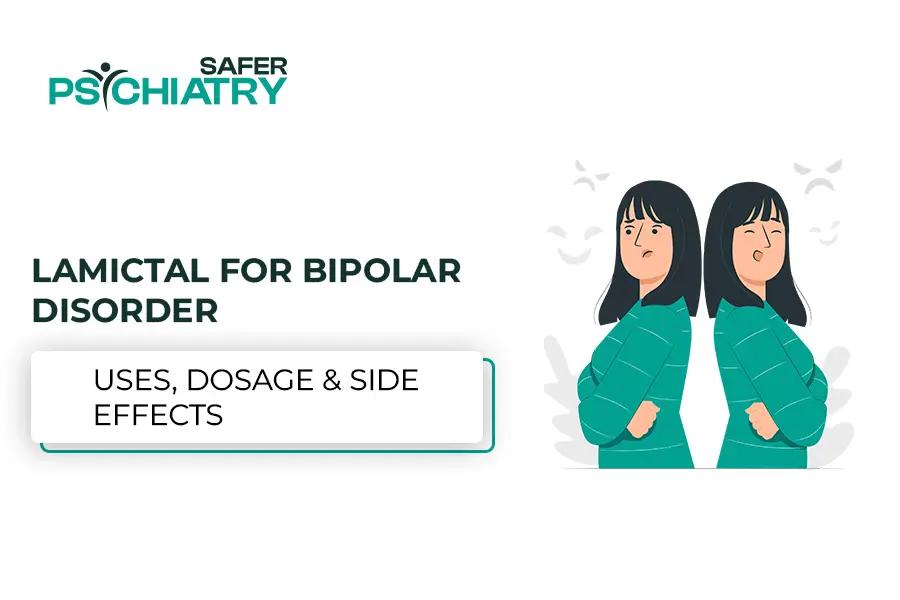
Lamictal for Bipolar Disorder
A Patient-Friendly Guide
At Safer Psychiatry, we provide compassionate, evidence – based mental health care to support your well-being now and for the future – because your journey matters, and so do you.

- What It Is: Lamictal (lamotrigine) is an anticonvulsant approved for maintenance treatment in bipolar disorder.
- How It Helps: Best at preventing depressive episodes, less effective for acute mania.
- Who it’s For: Patients needing long-term stabilization with fewer side effects.
- Dosage: Typically titrated up to 200 mg daily; full effects may take weeks.
- Side Effects: Mostly mild, but watch for serious rash.
- When to See a Psychiatrist: Always consult your provider before starting or adjusting Lamictal.
What Is Lamictal for Bipolar Disorder?
Lamictal (generic name: lamotrigine) is an anticonvulsant medication approved by the U.S. Food and Drug Administration (FDA) for the maintenance treatment of bipolar disorder. Unlike some mood stabilizers, Lamictal is most effective in preventing future depressive episodes rather than treating acute mania.
At Safer Psychiatry (2025), we often recommend Lamictal for patients who need a long-term, steady option with fewer disruptive side effects compared to older medications.
How Does Lamictal Work in the Brain?
Lamictal works by regulating abnormal electrical activity in the brain and stabilizing mood. It helps reduce the extreme mood swings associated with bipolar disorder, particularly the recurrence of bipolar depression.
- Prevents depressive episodes: Especially helpful for individuals who experience repeated depressive cycles.
- Supports mood stability: By maintaining balance, Lamictal can reduce the risk of both mania and depression over time.
- Gentler on cognition: Many patients report feeling “close to normal” without the “slowed down” sensation some other mood stabilizers cause.
Who Should Consider Lamictal?
Lamictal may be a good option for:
- Adults diagnosed with bipolar I or II disorder
- Individuals who mainly struggle with depressive episodes
- Patients who have not tolerated lithium or valproate well
- People looking for a long-term maintenance treatment
It may not be the best option for people experiencing acute mania or those with a history of severe allergic reactions to medications.
Lamotrigine Dosage for Bipolar Disorder
Because of the rare risk of a severe rash, Lamictal must be started at a very low dose and slowly increased over several weeks.
- Typical target dose: 200 mg per day (sometimes higher if needed)
- Frequency: Usually once or twice daily
- Time to effectiveness: May take 6–8 weeks to see full benefit due to gradual titration
Common Lamotrigine Side Effects
Most people tolerate Lamictal well, but some may experience:
- Headache
- Dizziness or fatigue
- Nausea or stomach upset
- Blurred or double vision
- Rash
- Sleep changes (drowsiness or insomnia)
- Lack of coordination
Serious but Rare Side Effect:
In rare cases, Lamictal can cause Stevens-Johnson syndrome (SJS), a life-threatening rash. Symptoms may include fever, flu-like feelings, and skin blistering. Patients should contact their provider immediately if a rash develops.
How Lamictal Compares to Other Mood Stabilizers
- Lamictal vs. Lithium: Lamictal is better at preventing depression, while lithium is stronger against mania.
- Lamictal vs. Valproate: Lamictal usually has fewer metabolic side effects.
- Lamictal as a mood stabilizer: Provides a balanced option for long-term maintenance, especially for patients whose main challenge is depression.
Final Thoughts
Lamictal for bipolar disorder can be a safe and effective part of a long-term treatment plan. By preventing recurrent depressive episodes and minimizing disruptive side effects, it helps many patients maintain stability and quality of life.
If you’re considering Lamictal or want to review your current treatment plan, our providers at Safer Psychiatry are here to help.
Disclaimer: This article is for educational purposes only and is not a substitute for medical advice. Always consult a qualified healthcare provider before making changes to your treatment.
FAQ
Frequently Asked Questions
Is Lamictal effective for bipolar disorder?
Yes. Lamictal (lamotrigine) is approved for the long-term maintenance treatment of bipolar disorder, especially for preventing depressive episodes.
How long does it take Lamictal to start working?
Because the dose must be increased slowly, Lamictal may take 6–8 weeks before its full effects are felt.
Can Lamictal treat acute mania or hypomania?
No. Lamictal is not effective for acute mania. It works best for maintenance and prevention of future episodes.
What is the typical dose of Lamictal for bipolar disorder?
The target dose is usually 200 mg daily, though it may vary based on individual needs. Always follow your provider’s instructions.
What are the most common side effects of Lamictal?
Mild side effects may include headache, dizziness, nausea, sleep changes, and rash. Most are manageable and improve over time.
What is the most serious side effect of Lamictal?
A rare but serious side effect is Stevens-Johnson syndrome (SJS), a severe skin rash. Contact your provider immediately if you develop a rash.
Is Lamictal safe to take long-term?
Yes. Many patients take Lamictal for years as part of a maintenance plan, with good tolerability and fewer long-term side effects compared to some alternatives.
Our Company
Copyright © 2024 Safer Psychiatric Consulting Services


